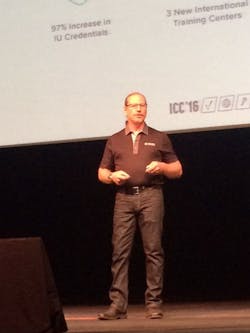Perhaps we need to stop talking about the Industrial Internet of Things and start talking about infrastructure, because the biggest problem manufacturers have has nothing to do with adding sensors for data collection and everything to do with how to connect legacy equipment to smart devices and the cloud.
There are workarounds coming in the form of new specifications to create more interoperability on the plant floor. However, adopting existing IT-based tools may just be what companies need to make Industrial Internet of Things (IIoT) applications a “near” plug-and-play deployment. That’s because, once the application development tools, networks and communication protocols are “open” and easy to connect to, the rest will fall into place.
That was the major message at the Ignition Community Conference (ICC) in Folsom, Calif., this week. This annual Inductive Automation event provided development workshops for system integrators, real-world examples of how the Ignition HMI/SCADA system is being used by end users, and a handful of new partners that are plugging in to the latest version of Ignition—which was announced this week.
Ignition, built with IT programming tools like Java and Python, is a single centralized server that acts as a hub for everything on the plant floor. It talks to plant floor equipment via OPC-UA as easy as it interacts with SQL databases, and includes unlimited free web-based clients that can be updated with the push of a button across multiple facilities.
The latest version, Ignition 7.9, adds revamped status and diagnostics, including a better user interface that displays at-a-glance performance information and reports. In addition, version 7.9 includes new set of tools that expand the way multiple gateways work together with distributed services tools.
Last year, the company introduced its enterprise administration module that allows users to securely scale and manage multiple gateways. This year, the company partnered with Cirrus Link to add distributed services on top of the gateway network. The new IIoT module leverages Cirrus Link’s Message Queue Telemetry Transport (MQTT) data transfer protocol specification to decouple intelligent devices from applications thereby creating a streamlined data pipe.
The Cirrus Link MQTT modules for Ignition include: MQTT Engine adding bidirectional communication to edge-of-the-network devices; MQTT Distributor adds an MQTT server that enables MQTT clients to securely connect, publish and subscribe to data; MQTT Injector emulates edge gateways and simulates live PLC data to aid in testing the functionality and throughout of IIoT setups; and MQTT Transmission providing an Ignition tag to MQTT bridge enabling connectivity into the MQTT infrastructure as a source of data for line of business applications and control.
Adding MQTT to Ignition is key to IIoT connectivity, the reason being is that MQTT is message-oriented middleware, acting as a broker between plant floor devices.
“You have to decouple devices from applications,” said Arlen Nipper, president and CTO of Cirrus Link Solutions. “If you take a device and connect it to a protocol instead of the infrastructure, you will never get to IIoT. No matter how smart you are about the application you are plugging into the device, tomorrow someone will ask for something different and you’ll be in the system changing it. Or worse, you ignore it and don’t innovate.”
Cirrus Link provides open source software, tools and a reference specification, called Sparkplug, to enable applications, sensors, devices and gateways to easily integrate with Ignition using the MQTT modules. As a result, Ignition is building out a strong ecosystem of partners.
For example, Opto 22 exhibited at ICC for the first time this year, displaying its SNAP PAC programmable automation controllers running Node-RED, a flow-based graphical development environment using the MQTT broker. It is a drag-and-drop configuration that once connected, allows other MQTT-based applications, like Ignition, to subscribe to that data.
“The cool thing is, when you configure it and define the tag names, when it shows up in Ignition all of the tag names are just like when you put it into Opto 22,” Nipper said.
Other examples include Hilscher North America’s netIOT Edge gateways which securely connect automation networks with cloud or any IoT application. OPC-UA and MQTT functions address objects in IoT field devices or in the cloud over standardized IoT protocols. And, Tyrion Integration, specializing in the oil and gas industry designed an IIoT gateway with built-in I/O, called Nucleus, which can pull data in real-time through the cloud or local interfaces.
“Those modules allow Ignition to turn into an edge of network application or into a cloud broker or to turn Ignition SCADA into a subscription client,” said Steve Hechtman, president and CEO of Inductive Automation.
But it all hinges on a move away from conventional architectures— where every I/O is connected to a PLC— to a new architecture of decoupling apps and end points where there is a single communication channel and everything is managed by a broker, Hechtman said.
About the Author
Stephanie Neil
Editor-in-Chief, OEM Magazine

Leaders relevant to this article:
